Knowledge of basic nutritional concepts is important for personal trainers as nutrition plays an integral role in the overall mechanics and health of the body. This chapter will review nutrition and its importance for athletic performance, foundational concepts in nutrition, popular diets, and general healthy eating guidelines.
Nutrition can be defined as the science of the nutrients in foods and their impact on the body. Taking the definition of nutrition a step further considers dietary choices and relevant human behaviors.1
Introduction to Nutritional Concepts
Importance of Nutrition for Health and Athletic Performance
Poor nutrition is one of the leading risk factors when it comes to both chronic disease as well as death in the United States.2
Large studies of over 2.88 million patients in total have all provided the same information – that being overweight or obese greatly increases the risk of death from chronic conditions such as cardiovascular disease, kidney disease, and diabetes.2
Of course, other factors play a role in the development of diseases.
It’s possible to have a genetic predisposition for conditions such as type 2 diabetes; however, research supports the concept that a healthy lifestyle can help with prevention of diabetes, despite any predisposition. 2
From a fitness standpoint, optimal nutrition can enhance athletic performance as well as provide proper recovery from exercise.3
It’s clear that nutrition plays a key role in all aspects of health and personal trainers will need to have a basic understanding of its concepts to be successful in working with clients.
The Trainer Academy CPT Scope of Practice
Personal trainers must respect their scope of practice when it comes to nutrition. In most states, there are laws in place that prevent individuals without the proper licensing and certifications from providing specific nutrition services, such as meal plans or recommendations for specific diseases.
Registered Dietitians or Registered Dietitian Nutritionists (RDs or RDNs) are individuals who earn bachelor’s degrees in nutrition and dietetics from accredited colleges or universities, complete a supervised clinical practice internship, pass a national examination, and maintain continuing education credits.
Because of their in-depth experience and qualifications, only RDs are legally allowed to provide specific nutrition prescriptions.4
However, personal trainers can provide basic nutrition recommendations and cite published dietary guidelines without specifically assigning certain foods. Overall, giving nutrition recommendations within the personal trainer scope of practice may be beneficial for their clients.
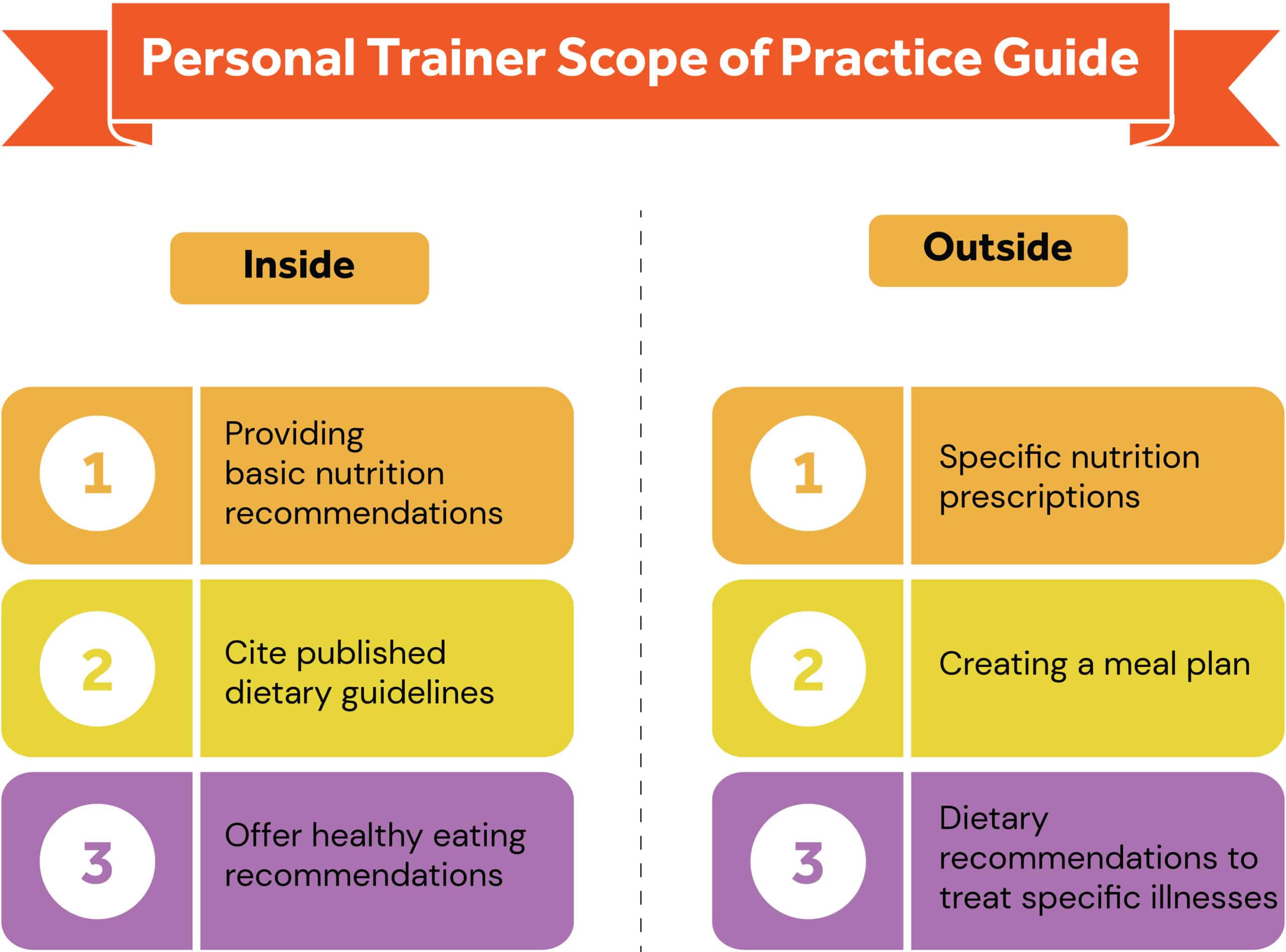
Basic Nutrition Concepts
Metabolism and Bioenergetics
One of the first steps in understanding nutrition and its effects on the body is to learn about energy balance.
This becomes important in the role of the personal trainer, especially when clients are looking to lose or gain weight.
A calorie is a measurement of heat energy. The energy in food is measured in calories, and denominated kilocalories.
Technically speaking, one kilocalorie is the amount of heat (energy) that is needed to raise the temperature of 1 kilogram (kg) of water by 1 degree Celsius.
However, most people refer to the energy found in food as simply “calories”. This textbook will use the abbreviation “kcal,” or the term “calories” moving forward to discuss energy intake and expenditure.5
Energy balance occurs when energy intake (in the form of calories from food) is roughly equal to energy expenditure (or the calories burned throughout the day). When energy is balanced, body weight remains stable. When a negative energy balance exists, meaning energy intake is less than the energy expended, body weight decreases.
Alternatively, in a state of positive energy balance, when calories eaten (energy intake) are greater than the calories being burned (energy expenditure), body weight increases.6 It’s worth noting that while this concept is indeed simple, it’s not always easy for those seeking to gain or lose weight. Obesity rates have increased over the years in part thanks to an environment with an abundance of highly palatable foods and societal decreases in physical activity.6
Total Daily Energy Expenditure (TDEE)
Total Daily Energy Expenditure, or TDEE, is the amount of energy that is expended in a 24-hour period. It’s a dynamic number that is affected by various factors day to day, including activity levels, the environment, caffeine, sleep, and other lifestyle factors.1
TDEE consists of three main components: the basal metabolism, physical activity, and the thermic effect of food
The thermic effect of food (TEF) is the energy that is required to process the food consumed and will account for about 10% of total energy expenditure.1
When food is ingested, the body needs to use energy to break it down to digest and absorb it. Interestingly, protein, when compared to carbohydrates and fats, has the highest thermic effect on food, increasing the metabolism an estimated 15-30% after ingestion. For reference, carbohydrates cause an increase of about 5-10% and fats just 0-3%.7, 8
Arguably the most variable component of TDEE among different individuals, as well as within one individual day to day, is physical activity, which can account for anywhere from 30 to 50% of someone’s energy expenditure.
A person’s physical activity is the amount of voluntary movement they are performing each day. This includes any form of movement, such as an active day job. For example, a mail delivery carrier has a certain amount of physical activity he or she performs every day through their job which contributes to their energy expenditure as well as any formal exercise they perform.1
NEAT, or Non-Exercise Activity Thermogenesis, is energy burned through day-to-day activities, aside from intentional exercise. For example, things like housework, getting up and stretching throughout the day, or even fidgeting, would count as NEAT.9
Lastly, the biggest contributor to TDEE, accounting for 50-65% of total energy expenditure, is the basal metabolism, which is the energy used to maintain life at a complete rest. This is often quantified by measuring the BMR (basal metabolic rate) or RMR (resting metabolic rate).1
BMR and RMR are often used interchangeably, but there is a small difference (up to 10%). BMR is measured in a lab setting via indirect calorimetry, where the individual has slept overnight in the lab and their values can be measured first thing in the morning.
On the other hand, RMR is also measured in a lab, but the individual did not stay overnight and has thus awoken and traveled to the lab setting for the testing. Ultimately, this means BMR will be slightly more accurate as it’s slightly more controlled.
Such differences are rather small and what’s more, BMR/RMR can change from day to day, depending on several factors like stressers, the use of caffeine, or the presence of a fever.1 It can also be increased or decreased over time by changes in lifestyle factors.
While it’s possible to measure BMR or RMR in a laboratory setting, this is not easily accessible for most individuals. Alternatively, several calculations have been developed to provide estimations.
Moving forward, this chapter will simply use the term BMR when discussing these calculations.
Calculations
There are many calculations that can be used to estimate BMR, but the Harris-Benedict equation, which considers an individual’s gender, height, and weight, is commonly used.10
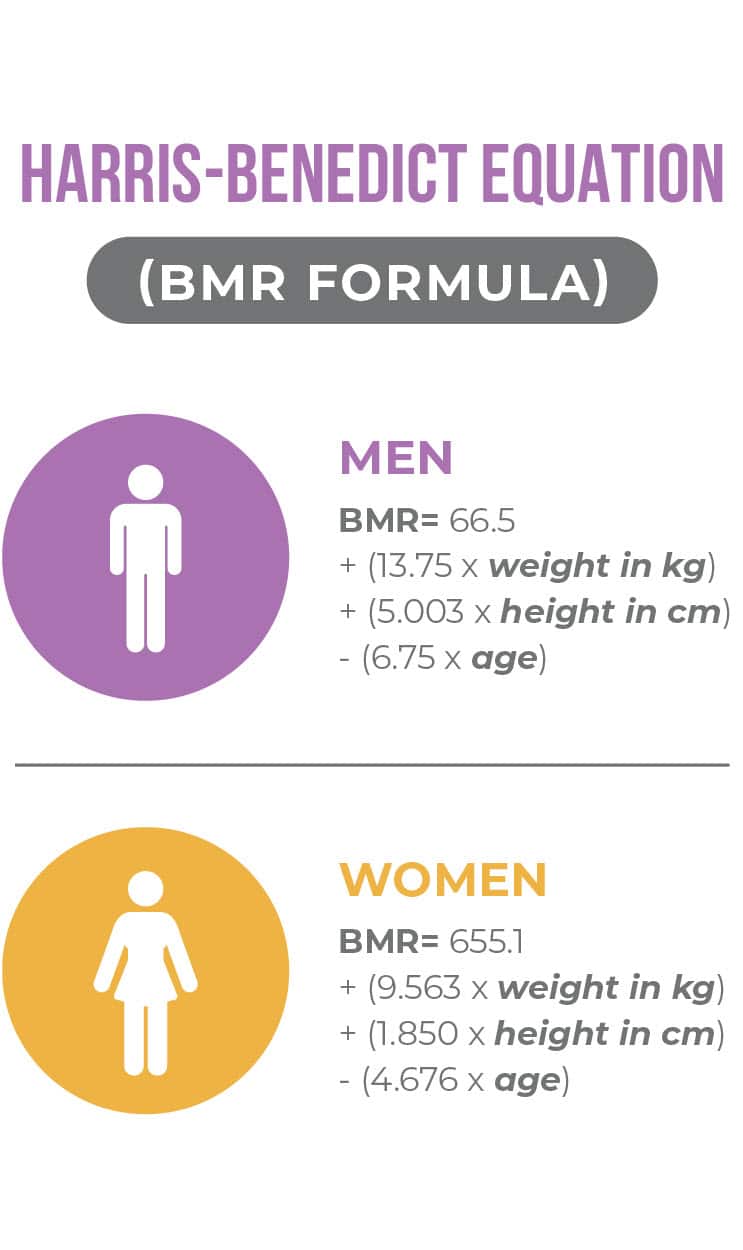
The result of these equations will be an estimate of an individual’s BMR.
From there, the activity level of that individual needs to be considered. To factor this in, the next step will be to multiply the result from the equation above by the appropriate activity factor below:
Energy Expenditure Calculations via BMR
| Activity level | BMR multiplied by: |
| Little to no exercise | 1.2 |
| Light exercise (1-3 days per week) | 1.375 |
| Moderate exercise (3-5 days per week) | 1.55 |
| Heavy exercise (6-7 days per week) | 1.725 |
| Very heavy exercise (twice per day, daily) | 1.9 |
After multiplying the BMR by the activity factor, the result is an individual’s TDEE, or the estimated number of calories they need to consume daily to maintain their body weight at their current activity levels.
While these calculations are used when indirect calorimetry is not available or accessible, it’s important to note that they are not 100% accurate.10
Increasing TDEE will likely be a goal of many personal training clients, particularly those looking to lose weight.
As a reminder, weight loss is typically observed when a negative energy balance is achieved, meaning the energy intake is less than the energy expenditure. Therefore, increasing TDEE would help promote a negative energy balance and ultimately, weight loss.
The most obvious method of increasing TDEE is to increase the amount of physical activity. This can be done through NEAT, or increasing overall movements throughout the day, as well as formal, structured exercise like sessions with a personal trainer or going for a bike ride or walk.
Another approach to increasing TDEE might be considering a diet higher in protein, as protein has a higher TEF than carbohydrates or fats. However, while this may lead to modest increases in TDEE, it’s unlikely to be substantial.7, 8 Lastly, research suggests that an increase in lean body mass may increase BMR and therefore TDEE, so promoting strength training and muscle building with clients is recommended.11
Calories
Changing caloric intake is an effective approach to changing body weight. As reviewed in earlier sections, a negative energy balance occurs when the calories eaten are fewer than the calories burned and thus results in weight loss and alternatively, a positive energy balance should promote weight gain.
A low-calorie diet typically involves anywhere from a 500-750 calorie deficit, meaning the difference between an individual’s caloric intake and TDEE is 500-750 calories.12
For many, eating this many fewer calories each day is difficult, and a more modest deficit may be more realistic. While a smaller deficit may lead to slower weight loss results, it may be more effective overall as it’s likely easier for an individual to commit to.13
Additional, increasing non-exercise activity thermogenesis (NEAT) by adding just a bit more movement to the day without additional exercise sessions can help individuals reach the target caloric deficit.
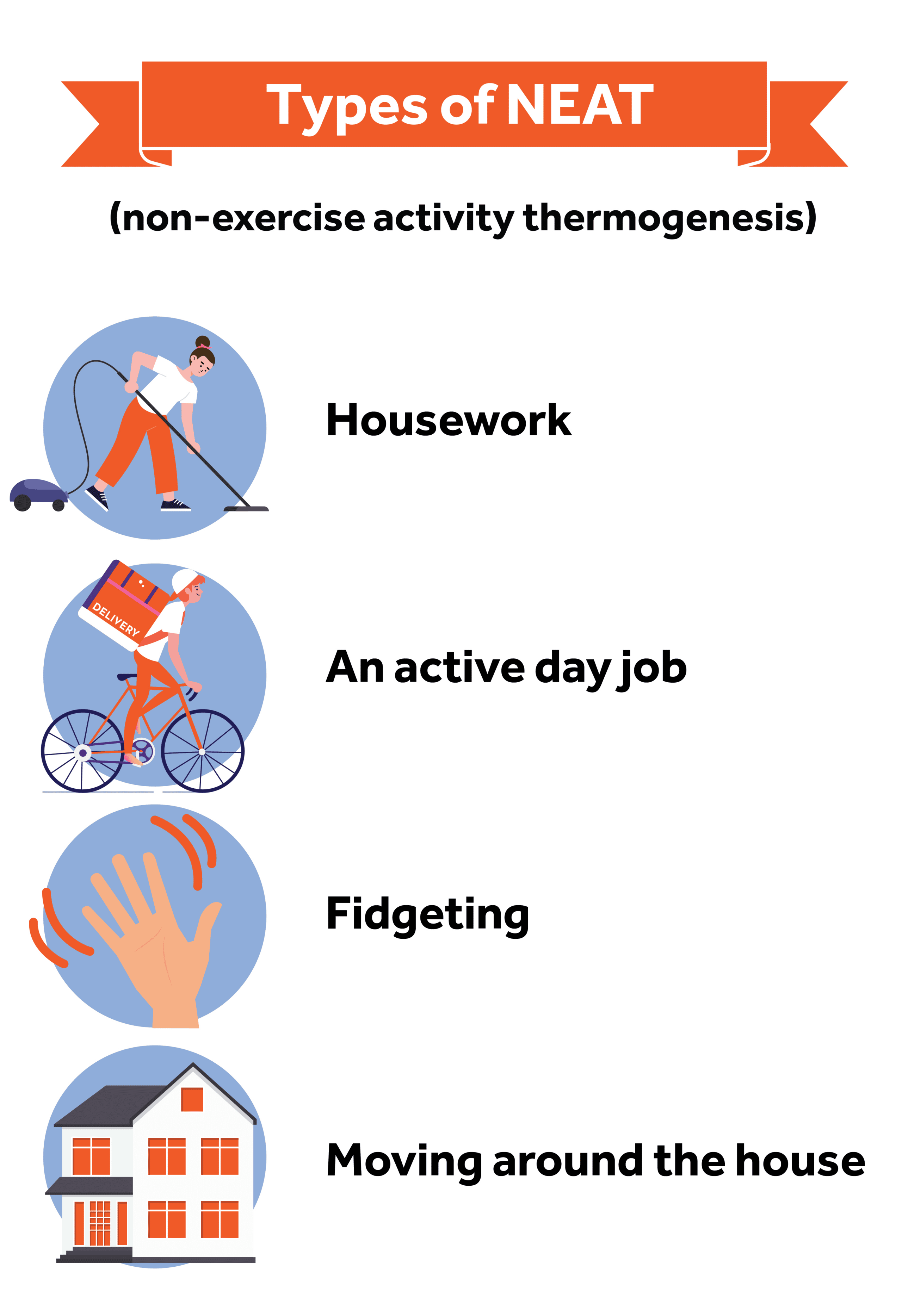
The success of a diet will rely heavily on an individual’s adherence to the diet. Research suggests that keeping a food log and choosing a diet that fits the individual’s food preferences are both effective strategies for improving adherence.13
Still, while there are many different approaches to weight loss, some of which will be reviewed in a later section, research has found that caloric intake is the most important factor.12
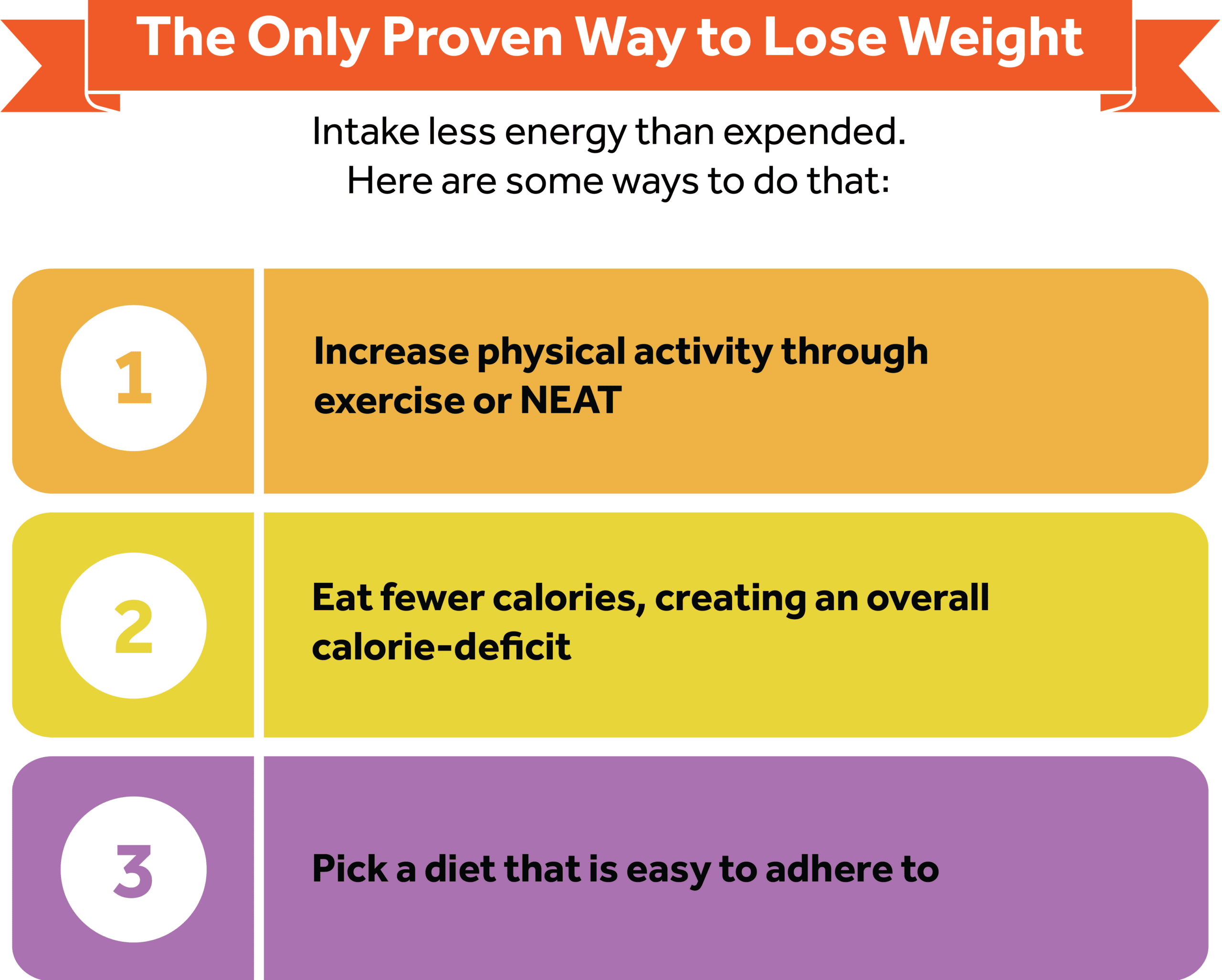
The same principles can be applied for an individual looking to gain weight, though the focus should shift to a caloric surplus.
It is again important for the approach to diet to be realistic and sustainable to achieve success.
Macronutrients
Macronutrients are compounds found in food that provide the body with energy, in the form of calories. There are three macronutrients present in foods: carbohydrates, fat, and protein.
Each of these provide a certain number of calories per gram, ultimately contributing to the total calories consumed in one’s dietary intake.
- One gram of carbohydrate contains 4 calories.
- One gram of protein contains 4 calories.
- One gram of fat contains 9 calories.
As fat contains more than twice the number of calories as carbohydrates and protein, it can be considered more calorie dense.
When it comes to weight loss, various approaches to macronutrients have been suggested. Research shows that caloric intake, along with sufficient protein intake, remains the most important factor.12
This means that whether a diet is lower in carbohydrates or fats does not determine the success of a diet. But, as adherence to a caloric deficit is a huge driving factor, an individual’s preferences towards foods higher in carbohydrates or fats should be considered.
Additionally, though not technically considered a macronutrient, alcohol also provides energy in the form of calories.
- One gram of alcohol (ethanol) contains 7 calories.
This can be notable for individuals working on losing weight as calories coming from alcohol will contribute to overall caloric intake.
Calories in typical alcoholic drinks
| Beverage | Serving Size | Total Calories | Calories from Alcohol |
| Beer | 12 fluid ounces | 153 | 96 |
| Light Beer | 12 fluid ounces | 103 | 76 |
| Red Wine | 5 fluid ounces | 125 | 108 |
| Spirits | 1 fluid ounce | 82 | 82 |
The table above indicates that some alcoholic beverages, such as beer and wine, contain calories in addition to the calories from alcohol, while spirits are 100% alcohol.
This is because beer and wine contain carbohydrates in addition to alcohol.
Hydration and Fluid Needs
Proper hydration should be considered an essential part of a nutritional plan, particularly when exercise is involved.
Water is an essential part of healthy nutrition.
It’s important for transporting nutrients throughout the body as well as carrying away waste products. It also helps to digest foods and regulate body temperature, especially during exercise.15
Athletes can lose large amounts of water through sweat during exercise. It’s estimated 1.5 liters or more fluid can be lost during each hour of activity.
To prevent dehydration, which occurs when the body’s output of water exceeds the input, individuals should focus on drinking plenty of fluids throughout the day, particularly before, during, and after exercise.1
Dehydration can lead to a rapid heartbeat, muscle weakness, low blood pressure, and other symptoms.
Recommendations for water intake can vary, but the Adequate Intake set by the DRI committee suggests 3 liters (about 13 cups) per day for adult men and 2.2 liters (about 9 cups) per day for adult women.16
It’s important to note that total water here is used interchangeably with total fluid intake, meaning other liquids, such as milk or fruit juice, and even foods, thanks to their water content, can contribute to this number.
If an individual is particularly active, they will likely need to increase their amount of total water. To determine an exact amount of fluids needed, the hourly sweat rate can be calculated by weighing an individual before exercise and immediately after.
One pound of weight loss is approximately 2 cups of fluid.1
This means that an individual should focus on consuming a minimum of 2 cups of water (or about 16 ounces) per pound lost to sweat during exercise. Sufficient fluids should also be prioritized leading up to and during training.
Also, remember that sweat is not simply just water. It also contains electrolytes, which are electrically charged particles that maintain water balance inside and outside of cells, and, therefore, are essential to hydration.15
Sodium, potassium, calcium, and magnesium are all important electrolytes, but sodium tends to be lost in the greatest amounts through sweat.
For example, an average individual will lose up to 800mg of sodium in 2 pounds of sweat, but only 10mg of magnesium.15
Low levels of sodium can lead to something called hyponatremia, which can cause nausea, confusion, fatigue, and muscle weakness.
Thus, staying on top of both fluids and electrolytes is important for hydration.
Sports drinks containing carbohydrates as well as sodium can be particularly useful during exercise, especially for heavy sweaters or individuals exercising for extended periods of time, though they are not necessary for everyone. An approach to hydration before, during, and after exercise might look like this1:
- Throughout the day: 1 ounce of fluids per 10 pounds of body weight
- 2 hours before exercise: 0.6 ounces per 10 pounds of body weight
- During exercise: Sips of fluids to prevent dehydration
- After exercise: 16 ounces of fluids per each pound of body weight lost during exercise
Popular Diets
Ketogenic Diet
The ketogenic diet, also known as the keto diet, is a high fat, very low carbohydrate diet that aims to establish ketosis in the body. In the ketogenic diet, people typically consume less than 10% of total calories from carbohydrates or fewer than 50 grams of carbohydrates per day.
Ketosis is a state in which the body begins to use fat as fuel, rather than its preferred fuel source of carbohydrates.12, 17
Originally used to help those suffering from epilepsy, the keto diet has more recently become popular for those looking to lose weight.18
Individuals following a keto diet generally see rather fast weight loss in the early stages of implementation. This is due to the diuretic effect of a low carbohydrate diet.17
Some research suggests that a keto diet may help decrease appetite and manage blood sugars and insulin levels.12, 19
However, the research overall does not favor a low carb or low fat diet, but rather calorie restriction for successful weight loss.12, 20
While the keto diet may be effective for some, it may not be realistic or sustainable for others. Because the biggest factor is calories, this is an example where the individual’s food preferences should be taken into consideration when considering a diet approach such as the keto diet.
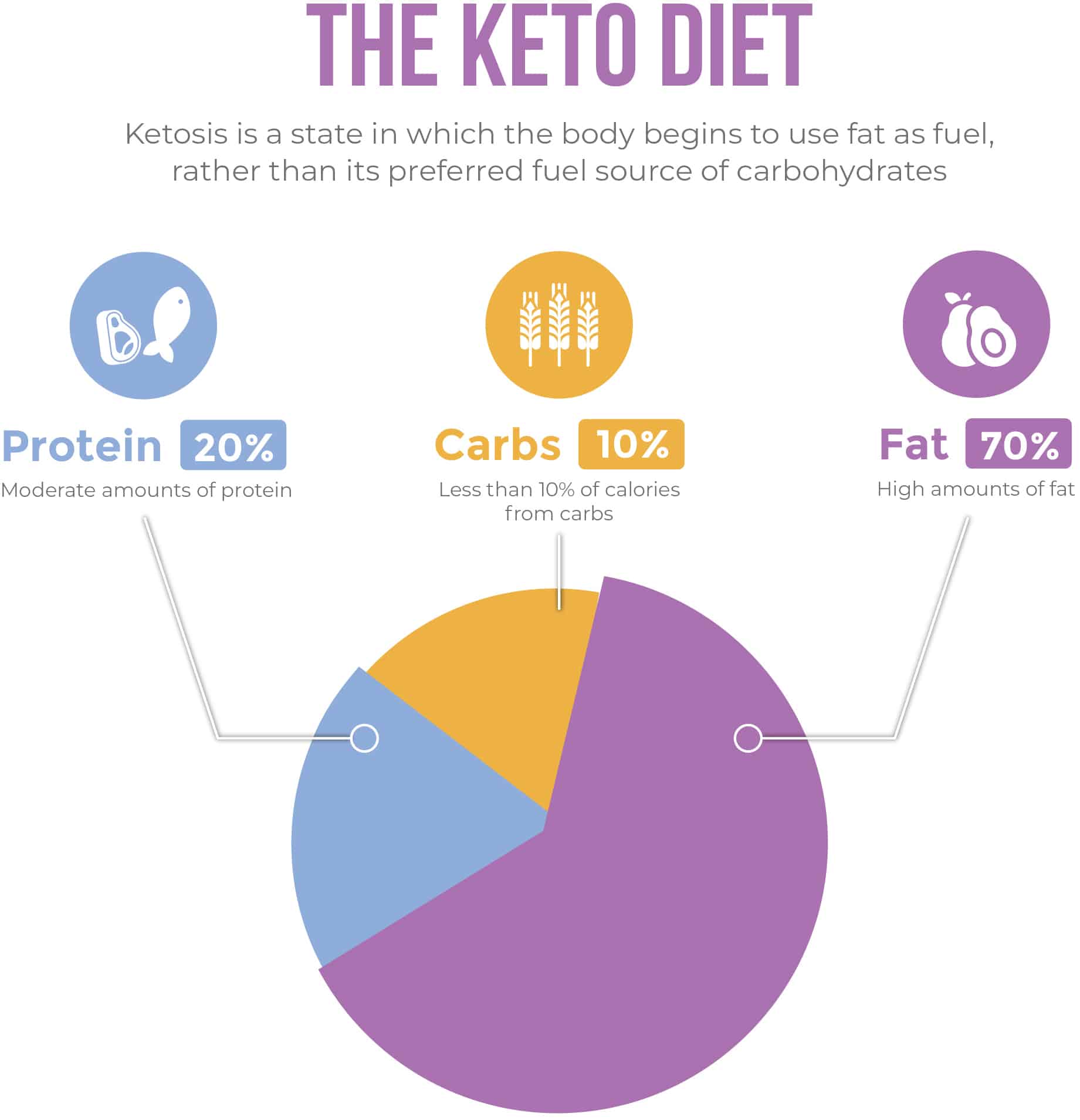
Paleo Diet
The Paleolithic diet, or the paleo diet, is a hunter-gatherer style of eating that focuses on eliminating processed foods, which were not consumed by humans during the Paleolithic era.
The diet revolves around consuming foods like meat, vegetables, fruits, and nuts. It eliminates grains, dairy, and added sugars. Today, the Paleo diet has become extremely popular and there are several heavily marketed products throughout the fitness industry, claiming to be Paleo.
Some research suggests that the paleo diet may help improve blood lipids and blood pressure, but stronger, more conclusive research is still needed before these claims can be made.12
Ultimately, there is no conclusive research supporting the paleo diet over other types of diets for fat loss. It can also be rather restrictive and difficult to sustain for some.
Vegan Diet
Vegan diets, or plant-based diets, eliminate all forms of animal products, including meats as well as foods derived from animals like dairy and eggs.
Some research does support a vegan diet for fat loss as its emphasis on plant-based foods may help improve insulin sensitivity, lower caloric intake, lower the risk of some chronic diseases, and ultimately promote weight loss.21
Some nutrients can become of concern on a vegan diet, including protein, vitamin B12, vitamin D, iron, and calcium.
It’s possible to consume enough of these nutrients without eating animal products, but individuals must be educated in plant-based food sources to do so. Some may wish to use dietary supplements to cover any gaps in nutrition.22
As with other diets, a vegan diet could be difficult for some to follow, and individuals should focus on diets that fit their lifestyle and preferences.
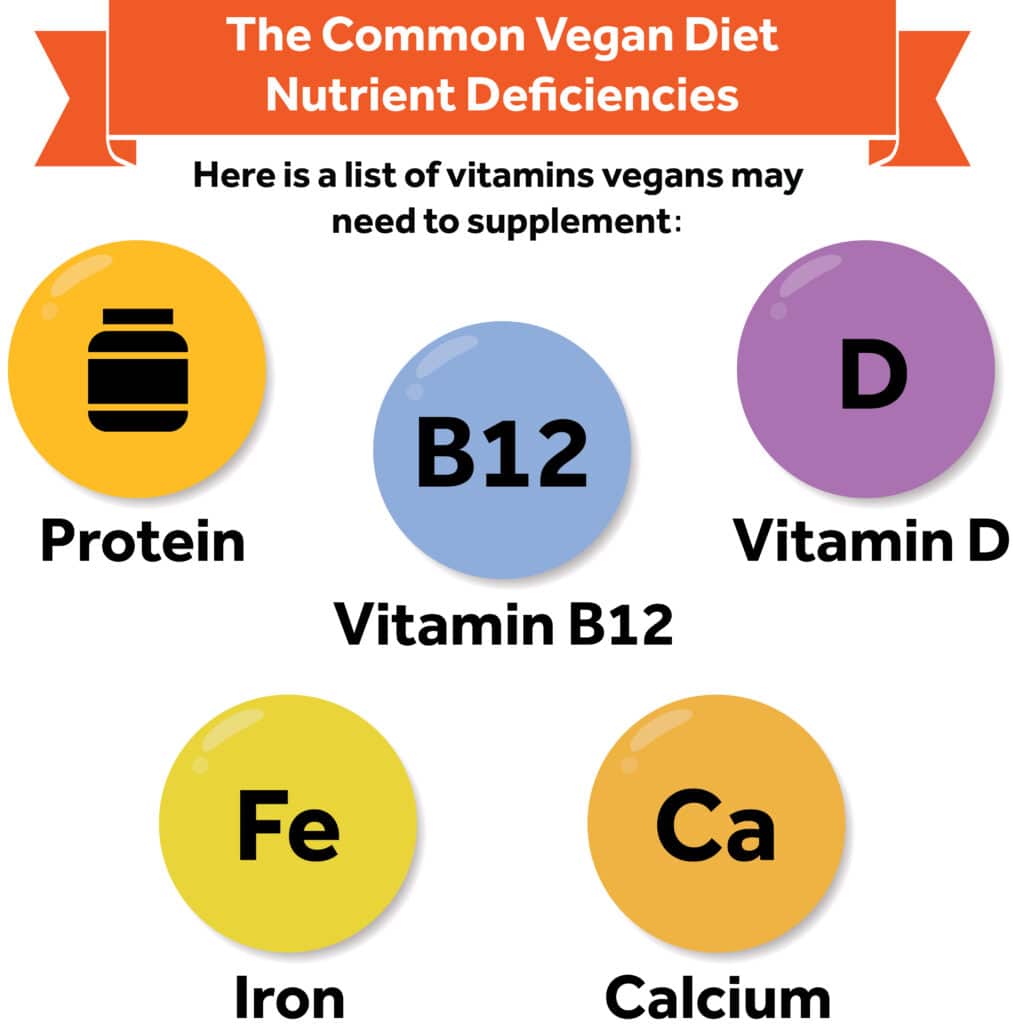
Vegetarian Diet
Vegetarian diets eliminate meat, but often include things like dairy and eggs.
This style of eating can be referred to as a lacto-ovo vegetarian diet.
Some vegetarians prefer to follow a lacto-vegetarian or an ovo-vegetarian diet, meaning only meat and eggs are restricted, or only meat and dairy are restricted. Same may also consider themselves pescatarian, meaning they do not consume meat, but do eat fish and seafood.
Vegetarian diets have been found to offer various health benefits, including a reduced risk for type 2 diabetes, heart disease, and cancer. Some research supports vegetarian diets for fat loss, but more conclusive research is still needed on the topic.12
Plant-Based Diet
A plant-based diet can be similar to a vegetarian or vegan diet but with a bit more flexibility. It’s a diet that emphasizes plant-based foods, but it may also include other whole foods, including animal products.23
Plant-based diets have been found to be beneficial in several ways, including lowering the risk of some chronic diseases, particularly heart disease, as they tend to be lower in saturated fats and higher in fiber.24 As with other diets, a plant-based diet may be beneficial for fat loss, but the most important factor in success remains a caloric deficit.12
Intermittent Fasting
Intermittent fasting is a style of eating that involves a certain length of time of fasting, followed by an “eating window,” during which all of one’s calories are consumed for the day.
There are several different approaches to intermittent fasting, some focusing on a 16 hour fast and 8 hour eating window, others recommending alternate day fasting, and more.12
Some potential benefits of intermittent fasting include improved insulin sensitivity and blood pressure.25
There is also promising research that suggests intermittent fasting may be effective for weight loss, however the research overall remains inconclusive.26
As with many diets, this style of eating can be rather restrictive and difficult to sustain and fasting can cause feelings of dizziness, weakness, and headaches in some.12
As a reminder, a caloric deficit is essential for weight loss, and some individuals may find that following an intermittent fasting approach helps them to maintain this deficit, but others may find fasting for longer periods lead to periods of overeating.
Summary of Popular Diets
Weight loss does not depend on the specific type of diet but the adherence to a long-term calorie-deficit.13
There are many different popular approaches to dieting and fat loss. While some may have research supporting their benefits and some may even have research supporting their effectiveness for fat loss specifically, the conclusion remains that caloric intake is the biggest driving factor.12, 27
Additionally, adherence to a specific diet ultimately determines the effectiveness of that diet. Some approaches, such as keeping a food log, setting realistic goals, and a supportive environment, have been found to improve adherence.13, 28
Many of these diets work by creating a caloric deficit, which is necessary to promote weight loss. Individuals should consider their own preferences and lifestyle before choosing to follow a specific diet.
Healthy Eating Guidelines
General Healthy Eating Recommendations
Despite the limited scope of the personal trainer, some general healthy eating recommendations can still be made. Before providing any sort of recommendation, consider if it would fall into the scope of diagnosing, treating, or preventing a specific condition or prescribing specific dietary approaches.
If the recommendation does fall into any of the latter, it’s best to refer the client to a registered dietitian.
Some general healthy eating recommendations for a client looking to lose weight or improve overall health might include:12, 13, 16, 29
- Drink plenty of water throughout the day (9-13 cups)
- Keep a food log
- Focus on high-fiber foods like vegetables, fruits, and whole grains to boost satiety
- Include a source of lean protein with each meal to increase satiety and support lean muscle mass
- Limit alcohol consumption
- Limit empty calories and ultra-processed foods
- Keep saturated fats and added sugars in moderation
Alternatively, if a client is interested in gaining weight, it’s best to continue recommending the above healthy eating guidelines, but it’s also important to encourage the following habits:
- Increase overall calories (in the form of carbohydrates, protein, and fat) by increasing portion sizes at meals and snacks
- Focus on protein to support muscle building and recovery
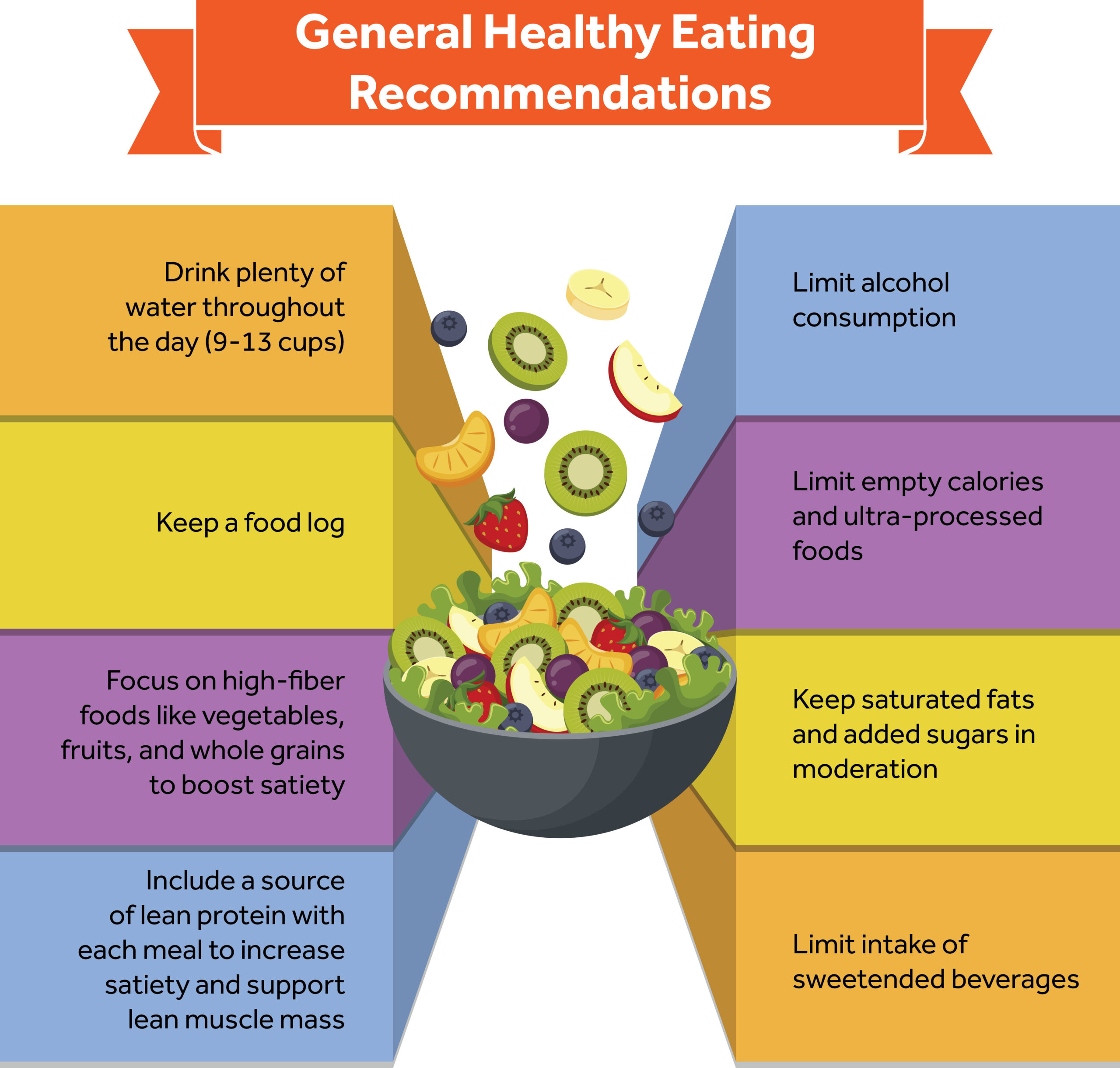
Alternatively, if a client is interested in gaining weight, it’s best to continue recommending the above healthy eating guidelines, but it’s also important to encourage the following habits:
- Increase overall calories (in the form of carbohydrates, protein, and fat) by increasing portion sizes at meals and snacks
- Focus on protein to support muscle building and recovery
Summary
The role of the personal trainer is centered around exercise and scope of practice must always be considered before offering any recommendations related to nutrition or other areas of expertise.
An individual’s TDEE can be calculated using equations that consider their gender, height, weight, and activity levels. This can be used to determine a caloric deficit or surplus that can support a goal of weight loss or gain.
Hydration is an essential aspect of nutrition and fitness, particularly in heavy sweaters. Clients should be encouraged to drink 9-13 cups of water, and sometimes more depending on their sweat rate.
While various weight loss diets exist, research remains steady in support of caloric intake and adherence being the biggest driving factors in success. An individual should first consider their own preferences and habits before committing to a restrictive diet.
While personal trainers are limited in their ability to make nutritional recommendations, they can offer several sound healthy eating recommendations to those looking to improve overall health.
Anything that involves diagnosing, treating, or prescribing specific dietary approaches should be referred to a registered dietitian.
References
- Eleanor Noss Whitney, Sharon Rady Rolfes. Understanding Nutrition. Cengage; 2018.
- Kandel S. An Evidence-based Look at the Effects of Diet on Health. Cureus. Published online May 22, 2019. https://doi.org/10.7759/cureus.4715
- Thomas DT, Erdman KA, Burke LM. American College of Sports Medicine Joint Position Statement. Nutrition and Athletic Performance [published correction appears in Med Sci Sports Exerc. 2017 Jan;49(1):222]. Med Sci Sports Exerc. 2016;48(3):543-568. https://doi.org/10.1249/MSS.0000000000000852
- What is a registered dietitian nutritionist. EatRightPro. https://www.eatrightpro.org/about-us/what-is-an-rdn-and-dtr/what-is-a-registered-dietitian-nutritionist.
- Osilla EV, Safadi AO, Sharma S. Calories. PubMed. Published 2022. https://pubmed.ncbi.nlm.nih.gov/29763084/#:~:text=Calories%20are%20a%20measure%20of
- Hill JO, Wyatt HR, Peters JC. The Importance of Energy Balance. European Endocrinology. 2010;9(2):111. https://doi.org/10.17925/ee.2013.09.02.111
- Calcagno M, Kahleova H, Alwarith J, et al. The Thermic Effect of Food: A Review. Journal of the American College of Nutrition. 2019;38(6):547-551. https://doi.org/10.1080/07315724.2018.1552544
- Pesta DH, Samuel VT. A high-protein diet for reducing body fat: mechanisms and possible caveats. Nutrition & Metabolism. 2014;11(1):53. https://doi.org/10.1186/1743-7075-11-53
- Levine JA. Non-exercise activity thermogenesis (NEAT). Best practice & research Clinical endocrinology & metabolism. 2002;16(4):679-702. https://doi.org/10.1053/beem.2002.0227
- Bendavid I, Lobo DN, Barazzoni R, et al. The centenary of the Harris–Benedict equations: How to assess energy requirements best? Recommendations from the ESPEN expert group. Clinical Nutrition. 2020;40(3). https://doi.org/10.1016/j.clnu.2020.11.012
- MacKenzie-Shalders K, Kelly JT, So D, Coffey VG, Byrne NM. The effect of exercise interventions on resting metabolic rate: A systematic review and meta-analysis. Journal of Sports Sciences. 2020;38(14):1635-1649. https://doi.org/10.1080/02640414.2020.1754716
- Kim JY. Optimal diet strategies for weight loss and weight loss maintenance. Journal of Obesity & Metabolic Syndrome. 2020;30(1). https://doi.org/10.7570/jomes20065
- Gibson A, Sainsbury A. Strategies to Improve Adherence to Dietary Weight Loss Interventions in Research and Real-World Settings. Behavioral Sciences. 2017;7(4):44. https://doi.org/10.3390/bs7030044
- SELF Nutrition Data | Food Facts, Information & Calorie Calculator. Self.com. Published 2007. https://nutritiondata.self.com/
- Clark N. Nancy Clark’s Sports Nutrition Guidebook. Sports Nutrition Services, Llc; 2020.
- Read “Dietary Reference Intakes: The Essential Guide to Nutrient Requirements” at NAP.edu. Accessed September 10, 2022. https://nap.nationalacademies.org/read/11537/chapter/15
- Masood W, Uppaluri KR. Ketogenic Diet. Nih.gov. Published March 21, 2019. https://www.ncbi.nlm.nih.gov/books/NBK499830/
- Ułamek-Kozioł M, Czuczwar SJ, Januszewski S, Pluta R. Ketogenic Diet and Epilepsy. Nutrients. 2019;11(10):2510. https://doi.org/10.3390/nu11102510
- Westman EC, Tondt J, Maguire E, Yancy WS. Implementing a low-carbohydrate, ketogenic diet to manage type 2 diabetes mellitus. Expert Review of Endocrinology & Metabolism. 2018;13(5):263-272. https://doi.org/10.1080/17446651.2018.1523713
- Seid H, Rosenbaum M. Low Carbohydrate and Low-Fat Diets: What We Don’t Know and Why we Should Know It. Nutrients. 2019;11(11):2749. https://doi.org/10.3390/nu11112749
- Najjar, Feresin. Plant-Based Diets in the Reduction of Body Fat: Physiological Effects and Biochemical Insights. Nutrients. 2019;11(11):2712. https://doi.org/10.3390/nu11112712
- Sakkas H, Bozidis P, Touzios C, et al. Nutritional Status and the Influence of the Vegan Diet on the Gut Microbiota and Human Health. Medicina. 2020;56(2). https://doi.org/10.3390/medicina56020088
- Storz MA. What makes a plant-based diet? a review of current concepts and proposal for a standardized plant-based dietary intervention checklist. European Journal of Clinical Nutrition. Published online October 21, 2021:1-12. https://doi.org/10.1038/s41430-021-01023-z
- Craig WJ, Mangels AR, Fresán U, et al. The Safe and Effective Use of Plant-Based Diets with Guidelines for Health Professionals. Nutrients. 2021;13(11):4144. https://doi.org/10.3390/nu13114144
- Sutton EF, Beyl R, Early KS, Cefalu WT, Ravussin E, Peterson CM. Early Time-Restricted Feeding Improves Insulin Sensitivity, Blood Pressure, and Oxidative Stress Even without Weight Loss in Men with Prediabetes. Cell Metabolism. 2018;27(6):1212-1221.e3. https://doi.org/10.1016/j.cmet.2018.04.010
- S W, R M, T O, et al. Intermittent fasting and weight loss: Systematic review. Canadian family physician Medecin de famille canadien. Published February 1, 2020. https://pubmed.ncbi.nlm.nih.gov/32060194/
- Freire R. Scientific evidence of diets for weight loss: different macronutrient composition, intermittent fasting and popular diets. Nutrition. 2019;69. https://doi.org/10.1016/j.nut.2019.07.001
- Sm F. Obesity: Risk factors, complications, and strategies for sustainable long-term weight management. Journal of the American Association of Nurse Practitioners. Published October 1, 2017. https://pubmed.ncbi.nlm.nih.gov/29024553/
- Cordova R, Kliemann N, Huybrechts I, et al. Consumption of ultra-processed foods associated with weight gain and obesity in adults: A multi-national cohort study. Clinical Nutrition. 2021;40(9):5079-5088. https://doi.org/10.1016/j.clnu.2021.08.009







